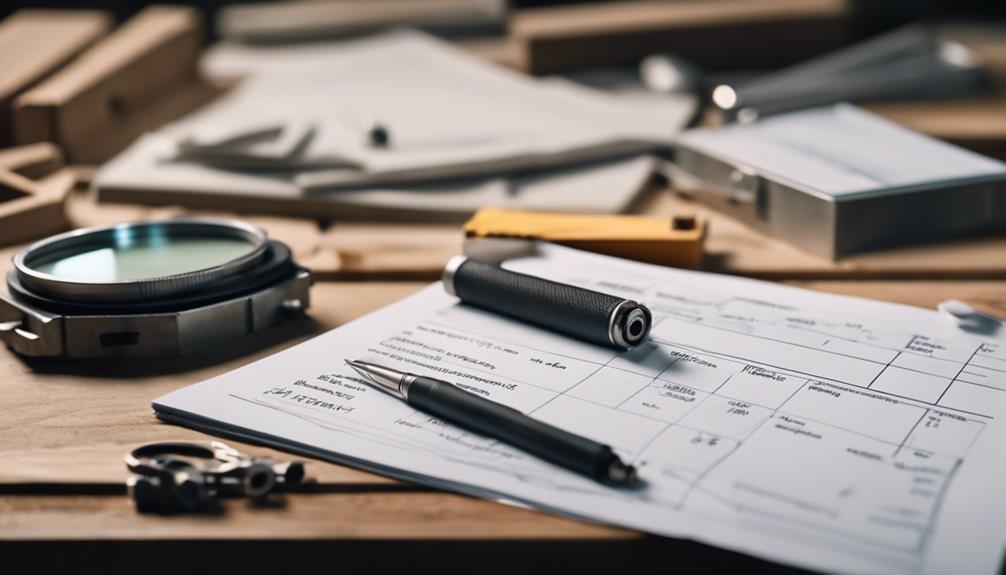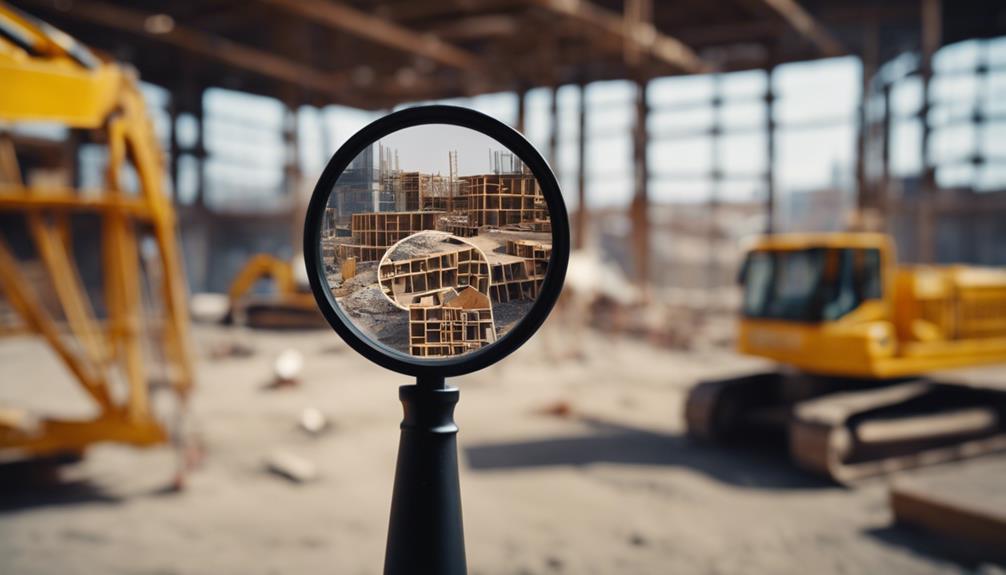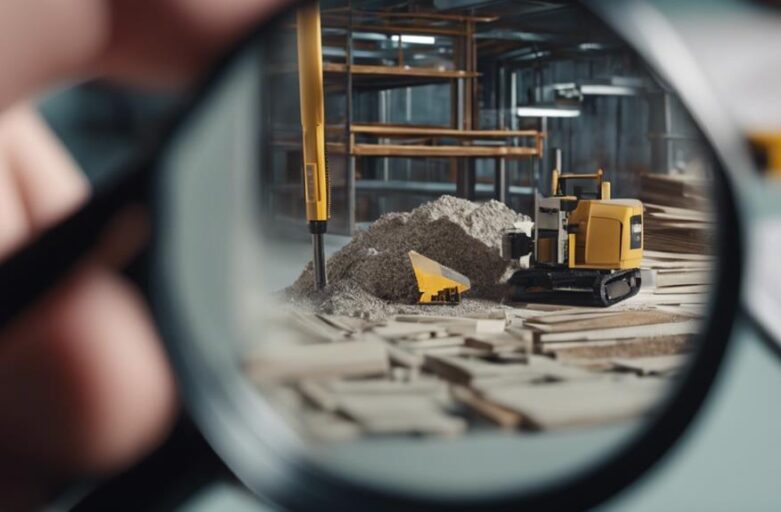Start by making a clear list of what you need from your construction materials. This is your acceptance criteria.
Next, create a step-by-step plan to inspect each item. Make a checklist to keep track of your quality checks. This will help you spot mistakes and ensure each material is up to standard.
If you find materials that aren't good enough, take action right away to fix the problem.
Lastly, always look for ways to make your process better. Building a structure is a big task, but these steps will help you make sure your materials are top-notch. This is super important for a successful build.
Keep learning, there's so much more to discover to help you become a great construction project manager.
Key Takeaways
- Make a detailed list that includes things like how the materials look, how big they are, and what they do, to help you pick the best ones.
- Have a plan to check all your materials carefully. This way, you can spot any problems early on.
- Use a checklist to make sure everything is up to par before starting the build. This can help avoid any errors.
- If you find materials that aren't good enough, fix the problem right away. Keep an eye on how well your fixes are working.
- Always try to make your processes better. Use what you learn from your checks to help, and don't be afraid to use new technology to help you improve.
Define Acceptance Criteria
Acceptance criteria are like a checklist for picking out the best materials for your construction project. They help you figure out if something is the right fit based on its qualities, size, look, and how well it works.
Imagine you're shopping for the perfect pair of shoes. You wouldn't just buy the first pair you see, right? You'd have criteria such as the right size, comfortable fit, a style you like, and a price you can afford. Acceptance criteria for construction materials are the same, but it's not just about how the materials look or how much they cost. They need to be strong, last a long time, and safe to use.
But remember, the world of construction is always changing. So, it's important to keep updating your checklist to match what's currently considered best in the industry and what your project needs. This will make sure you're always using the best materials.
When you know that the stuff you're using checks all your boxes, it feels good. It means you're doing your best to create a safe, professional, and high-quality project. Stick to your criteria, and your projects will be built to last.
Develop Inspection Plan
Once you know what you want from your construction materials, the next step is to make a plan for checking their quality. Think of this plan as a map that guides you towards the best materials.
Your plan will have special rules for checking the quality of each material. Not a single brick, beam, or bag of cement will be left unchecked. This will make sure that everything is up to standard, helping you achieve a top-notch project.
However, the plan isn't just a list of things to check. It also helps you spot any issues early on. This way, you can fix them before they turn into bigger problems. This not only keeps your standards high, but it also saves you from having to redo anything.
Making a plan means you're in control of your project's quality. You're not just hoping for the best. This is your project, and your name is on it. So, set your standards, make your rules, and let your plan lead you towards the best quality in construction materials.
Utilize Quality Control Checklists

Quality control checklists are like your best friend in a construction project. They make sure all the materials you use are top-notch. These checklists aren't just pieces of paper with some points. They help you check everything before you start building.
Using these checklists means you're trying to stop any mistakes before they happen. This way, all your materials will be the same high quality. When you're building, you're also creating a name for yourself. You want people to know you for your top-quality work.
The checklists also help you save money. How? Each time you check something off the list, you're making sure you won't need to fix it later. This way, you save both money and time.
Quality control checklists are like a map to a successful construction project. They're more than just tools; they guide you towards better results. So, make these checklists your friend. They'll help your project stand out for its quality and strength.
Implement Corrective Actions
In building projects, it's crucial to make sure your materials are top-notch. But what if they're not? Well, you need to fix things quickly. This could mean getting better materials, changing how you build, or altering your project plans. These quick fixes make sure your project is strong and keep other problems from popping up.
Keep track of everything you do. This isn't just about checking off items on a list. It's about showing that you're committed to using the best materials for your project.
Keep an eye on things after you've made changes. Don't just fix a problem and forget about it. Watch closely to see if your changes are working. If they're not, don't be scared to make more changes.
Here's a simple guide to follow:
| What to Do | Action to Take | What to Do After |
|---|---|---|
| Find Material Problems | Fix Them Fast | Watch and Change as Needed |
| Write Down Actions | Change Project Plans | Make Sure They're Followed |
| Stop Problems Before They Start | Change How You Build | Keep Up High Standards |
| Act Quickly | Keep Records | Keep Getting Better |
Review and Improve Processes

Maintaining top-notch quality in construction materials is a must-do, not a maybe. It's like a game of constant updates and tweaks to make sure everything is in tip-top shape. It's like being a detective, always on the lookout for clues to make things better.
Here's how you can be a top-notch quality detective. First, you need to keep an eye on how you get and use your materials. Think of it like a report card – you need to see where you're doing great and where you can do better. And, feedback from quality checks is like getting advice from your teacher on how to improve.
Data, or information, is your secret weapon. It's like your detective notebook, full of vital details from material checks and performance grades. This info helps you make smart choices on how to better your processes.
Don't forget your suppliers – the folks who give you your materials. Work with them like a team, making sure you all stick to the same high standards. Their tips and tricks can be super helpful, like getting insider info on the best ways to do things.
In this ever-changing world, your processes can't be old-fashioned. You need to keep updating your quality checks. It's like upgrading to a new video game version – better graphics, better gameplay. In the same way, technology can make your process faster and better.
Remember, in construction, quality is a habit, not a one-time thing. It's about building a culture of always aiming for the best and never settling for less.
These steps are like your detective toolkit – absolutely necessary if you're serious about guaranteeing top-quality construction materials. So, put on your detective hat and start cracking the case of quality improvement!
Conclusion
Alright, you're all set!
First, know what you want from your materials, this is your acceptance criteria.
Then, make a strong plan to check everything. Use a list to keep track of the quality.
If something's not right, fix it straight away. Also, be open to change and make your methods better.
Good quality construction materials are really important for your project. Don't settle for less.
Remember, this is your project, your vision. Make it the best!
You've totally got this!


